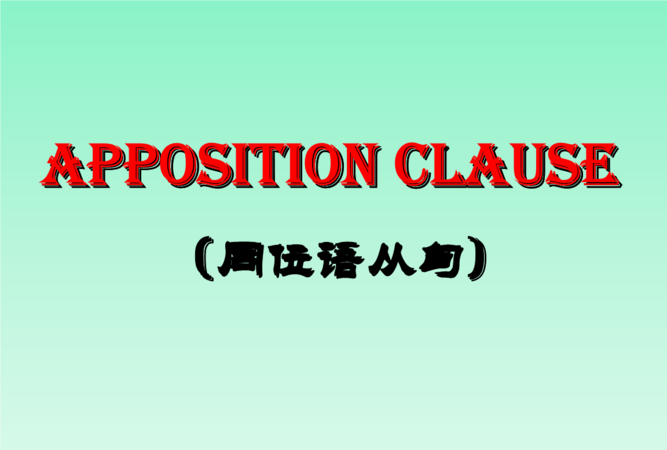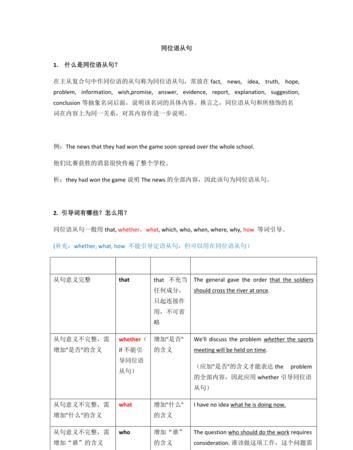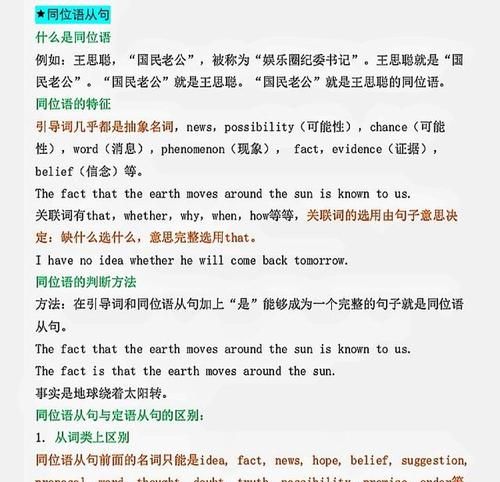本文目录
同位语从句是什么
同位语从句同位语从句在句中作某一名词的同位语,一般位于该名词(如:news, fact, idea, suggestion, promise等)之后,说明该名词的具体内容。
例如
I have no idea when he will be back.(when从句解释idea的内容)
The fact that he had not said anything surprised everybody.(that从句说明fact的内容)
==================详细看下面,关于引导词=====================
同位语从句的引导词,引导同位语从句的词语通常有连词that,whether,连接代词和连接副词等。
1. 连词that引导同位语从句
(注:引导同位语从句的that不能省略) The idea that you can do this work well without thinking is quite wrong.你认为不动脑筋就能做好这件工作
同位语从句的想法是完全错误的。(作idea的同位语)
【注意1】在某些名词(如demand,wish,suggestion,resolution等)后面的同位语从句要用虚拟语气
There was a suggestion that Brown should be dropped from the team. 有一项建议是布朗应该离队。
【注意2】引导同位语从句的连词that通常不省略,但在非正式文体中也可以省去。 He gabbed his suitcase and gave the impression he was boarding the Tokyo plane. 他拿起了手提箱,给人的印象是他要登上飞往东京的飞机了。
2. 连词whether引导同位语从句
(注:if不能引导同位语从句) The question whether we should call in a specialist was answered by the family doctor. 我们是否请专家由家庭医生来定。
【注意】whether 可引导同位语从句,但if不能引导同位语从句。
3.其它引导词引导的同位语从句
连接代词what,who,whom,whose,引导同位语从句 1).I have no idea what size shoes she wears.我不知道她穿几号的鞋。(what作定语)
同位语从句2).The question who will take his place is still not clear. (who作主语)
4. 连接副词引导同位语从句
连接副词when,where,how,why
We haven’t yet settled the question where we are going to spend our summer vacation.到哪儿去度暑假,这个问题我们还没有决定。
【先行词】
1.定语从句的先行词是名词或代词;而同位语从句的先行词只能是名词,而且仅限于idea,plan,fact,theory,promise,hope,news,doubt,truth,information,suggestion,question, thought,belief,conclusion等少数名词。
例如:
①The boy who is playing football is my classmate.
②Those who work hard will succeed.
③The fact that he had not said anything surprised everybody.
④The fact that you are talking about is important.
在①句中,划线部分是定语从句,其先行词是名词 boy,它不能用作同位语从句的先行词。
在②句中,划线部分也是定语从句,其先行词是代词those,代词不能用作同位语从句的先行词。
在③句中,划线部分是同位语从句,其先行词是名词fact,它同样可以用作定语从句的先行词,④句便是一例。
由以上分析可见,同位语从句的先行词一定可以用作定语从句的先行词,但定语从句的先行词不一定能用作同位语从句的先行词。
2.when,where,why引导的定语从句的先行词一定分别是表示时间、地点和原因的名词,而三者引导的同位语从句的先行词则肯定不是表示时间、地点和原因的名词。
例如:
①I still remember the day when I first came to Beijing.
②I have no idea when she will be back.
在①句中,划线部分是when引导的定语从句,其先行词day是表示时间的名词;
在②句中,划线部分是when引导的同位语从句,其先行词idea则不是表示时间的名词。
==============================================
希望帮到你哦~

如何简便准确地区分定语从句和同位语从句的关系
可以从以下几个方面来区分:
一、同位语从句的位置与定语从句的比较:
1、同位语从句与定语从句一样,都是用在名词后面。所不的就是:定语从句是修饰限制它前面的名词,因此,它是属于形容词从句。而同位语从句属于名词性从句,它是用来说明它前面的名词内容的,或者说是解释前面名词的内容。
2、同位语从句只用that作为开头(I have no idea除外),属于连词,在从句中不起成分作用,但不可省略。而定语从句是以关系代词、关系副词开头,它们在从句中起句子成分作用(作主语、宾语、表语、定语或状语),作宾语时可以省略。
3、只有在内容方面可以进一步阐明的名词(一般为抽象名词)才能带同位语从句,而几乎任何名词都可以带定语从句。
比较:
(1)The suggestion (that) she has given at the meeting is good.
(2)The suggestion that she should stay in the room is good.
(1)句中that she has given at the meeting这个从句说明了是她提出的建议,不是别人的建议,也就是限定了the suggestion的范围,但并没有说明建议的内容。从结构上分析,that是give的宾语,所以这个从句是定语从句。
(2)句的that she should stay in the room这个从句说明了建议的内容,同时,that只起连词作用,在从句中既不是主语,也不是宾语,但不能省略,所以它是同位语从句。
二、同位语从句前常用的名词:
同位语从句说明的名词常见的有:ability, advice, answer,belief, doubt, discovery, fact, fear, hope, idea, information, message,news, order, possibility, problem, proposal, question, story, suggestion, theory, thought, word(消息)等。而不可说明的名词是不会接同位语从句的。比如:man, water, sun等具体的人或事物。例如:
There is no doubt that the prices of cars will go down.
The belief that the company will make a great is shared by everyone.
三、where, when, why, how, who, what等在引导同位语从句时,一般只用于I have no idea结构中,其实,这种类型的同位语从句应该列入宾语从句的范畴,因为I have no idea意思就是I don\’t know...
如:I have no idea where I should go.
I have no idea how I can get to the railway station.
四、有时候主句的谓语比较短,同位语从句比较长,这个从句就不一定紧接在它所说明的名词后面。如:
Word(消息) came that our Chinese women team had beaten Japanese.

同位语从句修饰什么名词
额,比较抽象的名词,比如idea,doubt,fact等。不过这些名词什么的不用太在意的,同位语从句主要是看引导词在句中做不做成分。这也是跟定语从句的区别。希望可以帮助你哦~

哪些名词后跟同位语从句
同位语从句一般是对表示动作、状态、品质或其他抽象概念具体说明或解释,如news,idea,fact,promise,question,doubt,thought,hope,message,suggestion,words(消息),possibility,decision,等等

以上就是关于同位语从句位于什么之后 ,同位语从句是什么的全部内容,以及同位语从句位于什么之后 的相关内容,希望能够帮到您。
